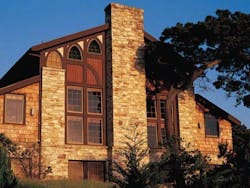Eskew + Dumez + Ripple receives AIA's 2014 Architecture Firm Award
Reinventing the Crescent: New Orleans Riverfront Development Plan, a 2012 AIA Honor Award recipient that adds a series of public spaces and residences to a 6-mile stretch of the Mississippi River, re-urbanizing it, and re-connecting it to the city. The Louisiana State History Museum in Baton Rouge, a faintly distorted cube that welcomes visitors with a large covered porch entry pavilion, framing exquisite views of Louisiana’s Art Deco state capitol. 930 Poydras Residential Tower in New Orleans, which groups public programs and amenities for this sleek, Modernist monolith together midway through the building in a “sky lobby” that slyly cantilevers out over the French Quarter. The Make It Right L9 Prototype House in New Orleans, a breezy Modernist house that recalls vernacular shotgun bungalows, updated with solar water heaters, solar power collectors, a rain water cistern, and more sustainability and energy efficiency systems that can reduce operating costs, increasing affordability for low-income residents.Eskew + Dumez + Ripple is the 51th AIA Architecture Firm Award recipient. Previous recipients of the AIA Firm Award include, VJAA (2012), BNIM (2011), Pugh + Scarpa (2010), Kieran Timberlake (2008), Muphy/Jahn (2005), Polshek Partnership (1992), Venturi, Raunch, and Scott Brown (1985), I.M. Pei and Partners (1968), and SOM (1962). You can learn more about Eskew + Dumez + Ripple and see images of their work here:http://www.aia.org/practicing/awards/2014/architecture-firm/eskew-dumez-ripple/
Morgan honored posthumously with Gold Medal
In other Board action, the AIA has announced that it will posthumously award the 2014 AIA Gold Medal to Julia Morgan, FAIA, whose extensive body of work has served as an inspiration to several generations of architects.
The AIA Gold Medal, voted on annually, is considered to be the profession’s highest honor that an individual can receive. The Gold Medal honors an individual whose significant body of work has had a lasting influence on the theory and practice of architecture. Morgan’s legacy will be honored at the AIA 2014 National Convention and Design Exposition in Chicago.
Morgan, who died in 1957, won a litany of firsts she used to establish a new precedent for greatness. A building technology expert that was professionally adopted by some of the most powerful post-Gilded age patrons imaginable, Morgan practiced for nearly 50 years and designed more than 700 buildings of almost every type, including houses, churches, hotels, commercial buildings, and museums. The first woman admitted to the prestigious architecture school at the Ecoles des Beaux-Arts in Paris, Morgan designed comfortably in a wide range of historic styles.
“Julia Morgan is unquestionably among the greatest American architects of all time and a true California gem,” said Senator Dianne Feinstein (D-CA) in her recommendation letter. “Morgan’s legacy has only grown over the years. She was an architect of remarkable breadth, depth, and consistency of exceptional work, and she is widely known by the quality of her work by those who practice, teach, and appreciate architecture.”
Born in 1872, Morgan grew up in Oakland, Calif. Exceptionally bright from a young age, she was one of the first women to study civil engineering at the University of California-Berkeley, where she caught the eye of AIA Gold Medalist Bernard Maybeck, who taught there. He gave Morgan what he would give the best and brightest of any gender: a recommendation to apply for the Ecoles des Beaux-Arts, the most prominent architecture school of its day. But there were two problems: She was a foreigner, and subject to unstated, but strict quotas, and a woman. No female had ever been admitted. She failed the first entrance exam; her second exam was discounted for no other reason than her gender. She was finally admitted after her third try. She completed the entire program in 1902.
Back in Berkeley, Morgan went to work for architect John Galen Howard, designing buildings for her undergraduate alma mater. In 1904, she became the first women licensed to practice architecture in California, and opened her own firm.
An early project was an open air Classical Greek theater; the first such structure in the nation. After the 1906 San Francisco Earthquake, much of the city was leveled, but her greek theater survived, providing her with a level of unprecedented credibility. In addition to this project solidifying her reputation, the project also brought her closer into the orbit of Phoebe Apperson Hearst, a university booster and mother to publishing magnate William Randolph Hearst. Word of Morgan’s skill with reinforced concrete spread across California. She began to take advantage of the material’s groundbreaking plasticity and flexibility in imaginative, new ways, savoring opportunities to clamber through scaffolding at buildings sites to inspect the work.
What stands out most is the vast array of architectural styles she employed: Tudor and Georgian houses, Romanesque Revival churches, and Spanish Colonial country estates with an Islamic tinge. Her late-period Beaux-Arts education gave her the ability to design in these historicist styles, gathering up motifs and methods from all of Western architectural history to select the approach most appropriate for each unique site and context.
“She designed buildings to fit her clients, blending design strategy with structural articulation in a way that was expressive and contextual, leaving us a legacy of treasures that were as revered when she created them as they are cherished today,” wrote AIA Gold Medalist Michael Graves, FAIA, in a recommendation letter.
St. John’s Presbyterian Church in Berkeley, an excellent example of First Bay architecture. An intimately scaled church, its interior is entirely clad in redwood, including open cross-strut beams that create a sense of humble grace and wonderment. Asilomar YWCA in Pacific Grove, Calif., this YWCA conference center (Morgan designed approximately 30 YWCAs) is perhaps the largest Arts and Crafts campus complex anywhere, according to Sara Holmes Boutelle’s book Julia Morgan Architect. Its palette of rich natural materials and fluid mix of indoor and outdoor spaces suits its pleasant Northern California climate. The Hearst Castle in San Simeon, Calif., William Randolph Hearts’ seaside retreat, 165 rooms across 250,000 acres, all dripping with detailing that’s opulent bordering on delirious. The style is generally Spanish Colonial, but the estate seems to compress Morgan’s skill at operating in different design languages: Gothic, Neoclassical, as well as Spanish Colonial, all into one commission. Morgan joined the AIA in 1921 as only the seventh female member. She is the 70th AIA Gold Medalist and joins the ranks of such visionaries as Thomas Jefferson (1993), Frank Lloyd Wright (1949), Louis Sullivan (1944), Le Corbusier (1961), Louis I. Kahn (1971), I.M. Pei (1979), Santiago Calatrava (2005), Glenn Murcutt (2009), and Thom Mayne (2013). In recognition of her legacy to architecture, her name will be chiseled into the granite Wall of Honor in the lobby of the AIA headquarters in Washington, D.C. You can learn more about Morgan and see images of her work here:http://www.aia.org/practicing/awards/2014/gold-medal/julia-morgan/
Topaz Medallion, Young and Kemper Awards announced
The AIA also announced that Harrison Fraker, Assoc. AIA, has been awarded the 2014 AIA/ACSA Topaz Medallion for Excellence in Architectural Education. Fraker, a professor of architecture at the University of California, Berkeley, pushed the academic study of energy use in buildings to the forefront of the sustainability movement through decades of dedicated research.
Throughout his career, Fraker has made significant contributions to the educational mission of the AIA and ACSA, working to build the knowledgebase of practice and emphasizing the importance of practice within the academic sphere. The AIA/ACSA Topaz Medallion honors an individual who has been intensely involved in architecture education for more than a decade and whose teaching has influenced a broad range of students. Fraker will be honored at the annual ACSA convention in Miami in April, and in June at the AIA National Convention in Chicago.
Ivenue Love-Stanley, FAIA, will receive the 2014 Whitney M. Young Jr. Award. The award was granted in recognition of Love-Stanley’s career-long dedication to bringing design to underserved communities and to making design education, and education in general, inclusive and accessible to all. Love-Stanley will be honored in June at the 2014 AIA National Convention in Chicago.
Established in 1972, the Whitney M. Young Jr. Award has honored architects and organizations that embody the profession’s proactive social mandate through a range of commitments, including affordable housing, inclusiveness, and universal access. From humble beginnings in the public housing projects of Meridian, Miss., Love-Stanley went on to become the first African-American woman to graduate from the College of Architecture at Georgia Tech in 1977. She later became the first African-American woman to become a licensed architect in the Southeast. In 1978, she co-founded Atlanta-basedStanley, Love-Stanley with her husband, William Stanley, FAIA, who received the Whitney Young Award in 1995. Love-Stanley and Stanley are the first husband and wife to ever have both received the Whitney Young Award.The Edward C. Kemper Award will be bestowed on Fredric “Rick” Bell, FAIA, in recognition of his service to New York City and his commitment to sustainable design and public health. Named in honor of the AIA’s first executive director, the award is given annually to an architect who has contributed significantly to the profession through service to the AIA.With extensive experience in both public and private practice, Bell has dedicated his career to improving the lives of residents in New York City and the surrounding areas. He was appointed executive director of the AIA New York chapter in June 2001, mere months before the Sept. 11 attacks. In the aftermath of that disaster, he provided support to members who had been directly affected by the destruction and the subsequent economic downturn. Bell was instrumental in the effort to create AIA New York's storefront Center for Architecture, which has since become a model for similar architecture centers nationwide. Bell has served on numerous boards and committees, is an avid speaker and writer, and remains a staunch advocate for using architecture to positively affect public health and the environment.
About The American Institute of Architects
Founded in 1857, members of the American Institute of Architects consistently work to create more valuable, healthy, secure, and sustainable buildings, neighborhoods, and communities. Through nearly 300 state and local chapters, the AIA advocates for public policies that promote economic vitality and public well being. Members adhere to a code of ethics and conduct to ensure the highest professional standards. The AIA provides members with tools and resources to assist them in their careers and business as well as engaging civic and government leaders, and the public to find solutions to pressing issues facing our communities, institutions, nation and world. Visit www.aia.org.

